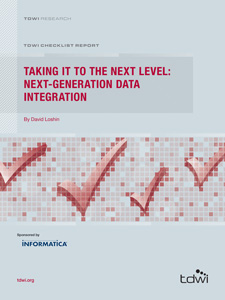
TDWI Checklist Report | Taking IT to the Next Level: Next-Generation Data Integration
March 1, 2013
The information technology (IT) vision for the future lies securely in the realm of data information. This we have learned from the growing publicity of “big data,” analytics, and the promise of improving the customer experience while increasing revenue via the collection, analysis, and synthesis of structured and unstructured data. Visionary stakeholders have recognized the value of expanding the visibility of shared information across business functions.
As data growth rates are predicted to increase five- to ten-fold by 2015, there is clearly a point at which the cost and effort associated with managing data will far outpace the rate of data volume expansion. And despite the decreasing cost of commodity hardware and availability of COTS tools for data integration and analytics, companies continue to struggle to deliver comprehensive data visibility in a way that meets business needs within a reasonable
time frame, while also containing the potential for increasing costs and fostering innovation.
Yet there are organizations that have succeeded at lowering costs and reducing delivery times while improving overall information visibility and usage—while also paving the way for leveraging emerging technologies such as the cloud or Hadoop. These organizations are the ones that have designed an IT road map that accommodates the expanding dependence on data integration and information availability through improved data management productivity and agility. This IT road map also transforms data integration from a series of tactical IT projects into an enterprise business function that is easily adaptable for future business demands.
The next generation of data integration takes this into account by seamlessly combining streamlined development with fully integrated data accessibility, quality, and utility. This TDWI Checklist Report presents a series of recommendations for developing a value justification for engaging business sponsors, as well as developing a strategic IT road map promoting the value of data architecture and data integration. In turn, informed decisions for assessing enterprisewide requirements for data acquisition, intake, integration, sharing, and retention will help companies succeed in satisfying the expanding breadth of the user communities, the growing desire to analyze rapid streams containing massive data volumes, and the increased reliance of automated systems on analytic results. These recommendations will help guide the reader in making decisions to manage the need for productive, yet innovative, data integration
projects while simultaneously managing effort and costs with the right amount of oversight.